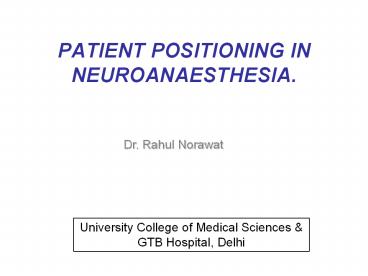PATIENT POSITIONING IN NEUROANAESTHESIA. - PowerPoint PPT Presentation
1 / 22
Title:
PATIENT POSITIONING IN NEUROANAESTHESIA.
Description:
PATIENT POSITIONING IN NEUROANAESTHESIA. Dr. Rahul Norawat University College of Medical Sciences & GTB Hospital, Delhi ... – PowerPoint PPT presentation
Number of Views:480
Avg rating:3.0/5.0
Title: PATIENT POSITIONING IN NEUROANAESTHESIA.
1
PATIENT POSITIONING IN NEUROANAESTHESIA.
Dr. Rahul Norawat
University College of Medical Sciences GTB
Hospital, Delhi
2
- Pathophysiology
- Neg. venous pressure exposure of veins boney
venous sinuses. - Surgical site is exposed to air located above
the level of heart, air may entrained in the
veins sinuses. - Consequences depends on volume, rate of entry, pt
position, use of N2O PFO (10-25 incidence) - Large VAE may CO by creating airlock Lt.
ventricular output.
3
Critical volume of air 200-300 ml or 3-5
ml/kg. The closer the vein of entrainment to
the Rt. heart the lower the critical volume.
4
Paradoxical Air Embolism
5
Presentation
6
- Detection
- Laboratory Studies
- Neither sensitive nor specific.
- Routine lab tests to evaluate the associated end
organ injury. - ABG
- Hypoxemia,
- Hypercapnia,
- Metabolic acidosis secondary to R-L pul shunting.
7
- Imaging Studies
- TEE most sensitivity. detect 0.02 ml/kg of air.
- Added advantage of identifying PAE.
- Precordial Doppler USG most sensitive noninvasive
method. detect as little as 0.05 ml/kg of
embolized air. - Incidence of VAE in sitting position,
- 20-50 with precordial Doppler,
- 76 with TEE, more sensitive.
8
- Transcranial Doppler USG commonly used to detect
cerebral microemboli. - CT detect VAE in axillary, subclavian veins, Rt.
ventricle pul. art. detect gt1 ml air,
specificity is best with large filling defects. - MRI show water conc. in affected tissues, not
reliable. - CXR normal or may show gas in the pul art system,
pul art dilatation, focal oligemia (Westermark
sign) pul edema.
9
Westermark sign
10
- Other Tests
- ECG - Low sensitivity. resemble
- venous thromboembolism
- Tachycardia,
- Rt ventricular strain pattern,
- ST depression.
- EtCO2 - Change in 2 mmHg EtCO2 is indicator.
nonspecific can occur with PE, massive blood
loss, hypotension, circulatory arrest, upper
airway obstruction.
11
- EtN2 - Most sensitive gas-sensing VAE detection
modality. - Pulse oximetry - Late findings, SpO2.
- Pul. artery catheter - Detect, PAP secondary to
mechanical obstruction/vasoconstriction from the
hypoxemia induced by VAE. insensitive monitor
(0.25 ml/kg). - Central venous catheter - Aspiration of air. CVP.
- Esophageal Stethoscope - low sensitivity, detect
mill wheel murmur (1.7 ml/kg/min).
12
- Management
- Notify surgeon asap.
- Administer 100 O2,
- Flood the field with saline, apply bone wax,
- Turn off nitrous oxide,
- Bilateral IJV compression,
- Avoid hypotension - vasopressors (ephedrine).
13
- Place patient in left lat decubitus
Trendelenburg position (Durant position). - Aspiration of entrained air- multi or single
orifice catheter placed at the high level of
right atrium. - PEEP cerebral VP,
- G-suit,
- Supportive therapy
- fluid resuscitation.
14
- Initiate CPR - Maintaining CO, break large air
bubbles into smaller and force air out of the rt
ventricle into the pul vessels. - Hyperbaric oxygen therapy (HBOT)
- Indications Neurological manifestations and
cardiovascular instability. - Benefits
- Compression of existing bubbles,
- Establishing a high diffusion gradient to speed
resolution of existing bubbles, - Improved oxygenation of ischemic tissues,
- Lowered ICP.
15
(No Transcript)
16
- Summary of Task Force Consensus on the Prevention
of Perioperative Peripheral Neuropathies Relevant
to Positioning for Neurosurgery . - Preoperative assessment
- Ascertain that patients can comfortably tolerate
the anticipated operative position.
17
- Upper extremity positioning
- Arm abduction should be limited to 90 in supine
patients patients who are positioned prone may
comfortably tolerate arm abduction gt90. - Position arms to decrease pressure on ulnar
groove (humerus). When arms are tucked at the
side, neutral forearm position is recommended.
When arms are abducted on armboards, either
supination or a neutral forearm position is
acceptable. - Prolonged pressure on the radial nerve in the
spiral groove of the humerus should be avoided. - Extension of the elbow beyond a comfortable range
may stretch the median nerve.
18
- Lower extremity positioning
- Prolonged pressure on the peroneal nerve at the
fibular head should be avoided. - Neither extension nor flexion of the hip
increases the risk of femoral neuropathy. - Protective padding
- Padded armboards may decrease the risk of upper
extremity neuropathy. - The use of chest rolls in laterally positioned
patients may decrease the risk of upper extremity
neuropathies. - Padding at the elbow and at the fibular head may
decrease the risk of upper and lower extremity
neuropathies, respectively.
19
- Equipment
- Properly functioning automated BP cuffs on the
upper arms do not affect the risk of upper
extremity neuropathies. - Shoulder braces in steep head-down positions may
increase the risk of brachial plexus
neuropathies. - Postoperative assessment
- A simple postoperative assessment of extremity
nerve function may lead to early recognition of
peripheral neuropathies.
20
- Documentation
- Charting specific position actions during the
care of patients may result in improvements of
care by helping practitioners focus attention on
relevant aspect of patient positioning and
providing information that continuous improvement
processes can use to lead to refinement in
patient care.
21
- References
- Miller RD. Anesthesia. 7th ed. NY Churchill
Livingstone Inc. 2010. - Clinical Anaesthesia, Barash, Cullen Stoelting,
5thed. - Rozet I, Vavilala S. Risks and Benefits of
Patient Positioning During Neurosurgical Care
Anesthesiol Clin. 2007 Sept 25(3) 631-62. - American Society of Anesthesiologists. Task Force
on the Prevention of Perioperative Peripheral
Neuropathies Practice Advisory for the
Prevention of Perioperative Peripheral
Neuropathies. Anesthesiology 200092 11681182. - American Society of Anesthesiologists. Mirski A
etal, Diagnosis and Treatment of Vascular Air
Embolism Anesthesiology 2007 10616477.
22
- Thank you..































